More than 30 years ago I tied some of the North Country Flies on blind hooks. At that time Veniard Ltd. had them in their catalogue - but I had no silk-worm gut, so I tied them to fine monofile nylon.

More than 30 years ago I tied some of the North Country Flies on blind hooks. At that time Veniard Ltd. had them in their catalogue - but I had no silk-worm gut, so I tied them to fine monofile nylon. I had bought a lot of the famous old books about these flies - T.E. Pritt, F.M.Walbran and Edmonds & Lee among others. They could at that time be bought for ordinary money! Now-a-days they are so expensive, that they are out of reach for the ordinary flytyer; but fortunately there has in the last years been issued new editions, that can be bought at a reasonable prize.
Then came a period where I was mostly engaged in dryflies, nymphs and last my dear friend, the late Vernon S. (Pete) Hidy's Flymphs.
Now after many years I haven taken it up again. Mostly as a result of the impulses I have got reading books like Sylvester Nemes "The Soft-Hackled Fly Addict' and the english Leslie Magee "Fly Fishing - The North Country Tradition" and Roger Fogg "The Handbook of North Country Flies". Being late in my carreer as fly-tyer I wanted to tie them as close to the original as possible and that meant that I had to look around after old blind hooks and silk-worm gut. With the generous help from a lot of my friends I have got samples of both and could start my work. I had still a few of the old hooks from Veniard and these I used for training until I dared start with the old, tapered blind hooks and real gut.
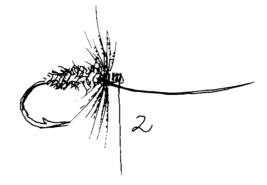

First I tied them in the same way I tie on eyed-hooks: Starting at the very end of the shank I tied the thread a few turns to the left. Then I placed one end of the gut (which I on beforehand had winched up in a narrow coil to minimize its 'volume') under the hook and tied it 'down' with three tight turns a little to the rear of the end of the hook. It is a spanish prof. fly-tyer who taught me to do it so to prevent the gut to come into direct contact with the sharp edge of the hook and be destroyed. Then I placed the prepared hackle on top and tied it down as I turned the thread to the rear. Surplus of stalk is cut away and the body formed. Is there a prescription of dubbing, then I wax the thread very light with a tacky wax and then with a pinch of dubbing between the thumb and index-finger on the right hand and the thread kept tight with the left I apply the dubbing with movements just as a guitar-player uses his plecter - that is: one most not touch the thread with the fingers, but only with the dubbing. Then one gets a very fine coat of dubbing, that let the thread be seen after winding.
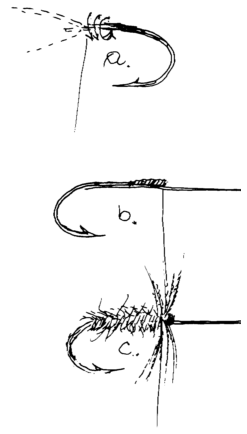
I turn the hackle, tie it down and wind the thread through the wound hackle and finish with a couple of half-hitches in front of the hackle. This last procedure can be something of a problem, when we as the custom is to-day have our thread on a bobbin-holder.
To overcome this I changed the last step in the tying - in stead of finishing with the half-hitches in front of the hackle I continued forward and with a half-hitch tool placed two knots on the exposed end of the hook.
Then a friend of mine pointed out that in accordance with W.C. Stewart one shall finish the tying with half-hitches behind the hackle and in front of the body. Has the fly a dubbed body, then I let some dubbing be on the thread when I tie the half-hitch-knots. Then they are hidden totally. My way of tying here is to tie the hackle down on top as usual with 2-3 turns of thread - then wind the hackle to the rear and then wind the thread through the hackle and tie it down behind the hackle...
To come even closer to the old drawings in the books I wound the thread at the start to the very tip of the hook - covering it totally. To make it more even I turned the hook in the vice and turned the thread in the opposite way around the hook (a) Then I turned the hook and wound the thread to the very end of the shank - giving the turns a coat of thin lacquer before I continued. Then I placed the gut under the shank and tied it down with 3-4 turns of thread to the rear - then tied the hackle down as mentioned above...
- Log in to post comments

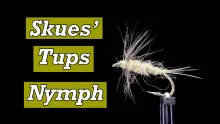
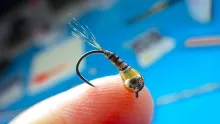
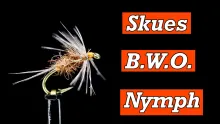
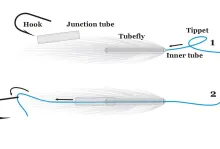



Hello,
I actually h
Hello,
I actually have a question for you...do you know from your books, which fly was "invented" by F M Walbran after an exasperating autumn days fishing for grayling on the R. Wharfe in 1888? ~ Would you believe this is a question in the Epsom Angling Society's Christmas Quiz! As coarse fisherman in Surrey, England I doubt most of them have ever caught a grayling let alone on an 1888 pattern fly.. Thank you very much. Kind regards.